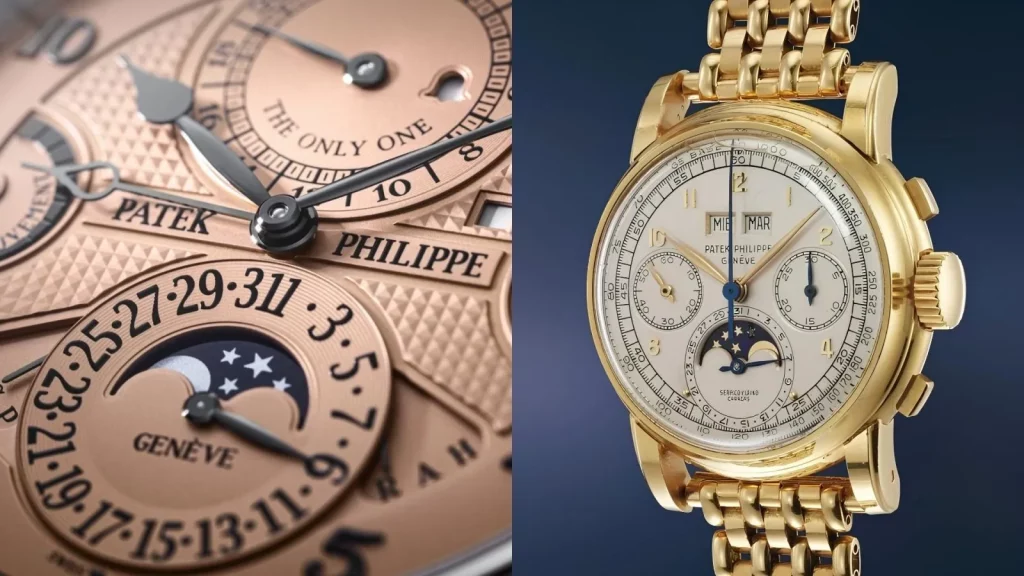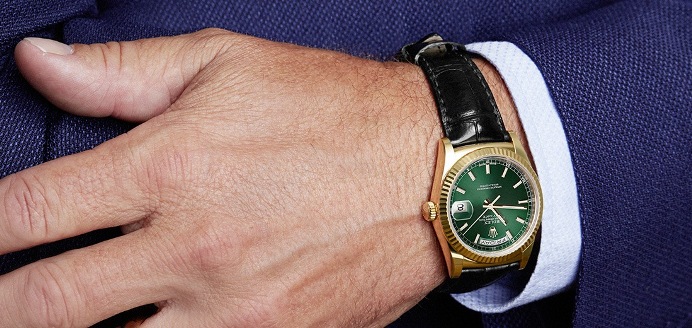Introduction
When discussing luxury watches, two names consistently stand above the rest: Rolex and Patek Philippe. These two Swiss watchmaking giants represent the pinnacle of horological craftsmanship, each with a rich history and a unique approach to timekeeping. But how do these two legendary brands compare? What distinguishes one from the other, and how have they earned their prestigious reputations?
In this article, we will explore the history, brand philosophy, and evolution of both Rolex and Patek Philippe, examining what makes each brand distinct in the world of fine timepieces. We’ll explore their founding stories, key innovations, and important milestones, comparing their strategies for building a legacy and maintaining relevance in an ever-evolving luxury market. This comparison will not only delve into the technical aspects of their timepieces but also examine how both brands have crafted their image and cultural influence over the decades.
By the end, we’ll answer the question: Which brand, Rolex or Patek Philippe, truly defines timeless luxury?
Chapter 1: The History of Rolex
1.1 Founding of Rolex
The Rolex brand was founded in 1905 by Hans Wilsdorf and his brother-in-law Alfred Davis in London, England. Originally named Wilsdorf and Davis, the company specialized in the distribution of high-quality Swiss watches to the British market. The duo had a vision for creating high-precision, reliable watches that could offer more than the traditional pocket watches of the time.
In 1908, Wilsdorf registered the trademark “Rolex,” a name he believed would be both easy to pronounce and memorable. He also moved the company’s operations to Geneva, Switzerland in 1919, after the end of World War I and the economic turmoil that affected England. This shift laid the foundation for Rolex to establish itself as a luxury Swiss watchmaker.
1.2 Rolex’s Early Innovations
Rolex’s quest for innovation began almost immediately, with several groundbreaking developments marking the brand’s early history:
- The First Waterproof Watch (1926): The Oyster case was a revolutionary creation, becoming the world’s first waterproof and dustproof wristwatch. This innovation made Rolex synonymous with rugged reliability and elevated the brand’s status in the watch industry.
- The Perpetual Movement (1931): Rolex introduced the self-winding mechanism, known as the Perpetual movement, which allowed the watch to wind itself using the motion of the wearer’s wrist. This invention would go on to be featured in nearly every Rolex model, from the Datejust to the Submariner.
- The Datejust (1945): The Rolex Datejust was the first automatic wristwatch to display the date through a window on the dial, a feature that would become standard in the watch industry.
1.3 Rolex’s Growth and Reputation
Over the next several decades, Rolex continued to innovate with professional watches for various fields, such as aviation, diving, and exploration. The brand’s rugged reliability and precision made it the watch of choice for adventurers, athletes, and celebrities alike.
- The Submariner (1953): As the first dive watch capable of withstanding extreme depths, the Rolex Submariner became the gold standard for dive watches and remains one of the brand’s most iconic pieces.
- The Explorer (1953): This watch became famous when it was worn by Sir Edmund Hillary during his historic climb of Mount Everest.
- The Cosmograph Daytona (1963): Known for its association with motorsport, the Daytona was designed for professional drivers, featuring a tachymeter scale to measure speed and lap times.
1.4 Rolex Today
Today, Rolex is not just a brand, but a global symbol of success and achievement. The company has been able to maintain a cult-like status, largely due to its impeccable reputation for craftsmanship, attention to detail, and precision. Rolex remains a privately held company and continues to dominate the luxury watch market with iconic models such as the Daytona, Submariner, Datejust, and GMT-Master.
Chapter 2: The History of Patek Philippe
2.1 The Founding of Patek Philippe
Founded in 1839 by Antoine Norbert de Patek and Jean-Adrien Philippe in Geneva, Switzerland, Patek Philippe was destined for greatness from the beginning. Patek, a Polish nobleman, and Philippe, a French watchmaker, formed a partnership based on their shared passion for creating highly intricate timepieces. Patek Philippe quickly gained a reputation for producing watches that went beyond mere timekeeping, becoming works of art and engineering.
2.2 Patek Philippe’s Early Innovations
Unlike Rolex, which was focused on precision and durability, Patek Philippe’s early work focused on complicated movements and the art of watchmaking.
- The First Wristwatch with a Complication (1868): Patek Philippe’s pioneering work in complicated timepieces began with the creation of the world’s first wristwatch with a complicated movement in 1868, which featured a minute repeater.
- The Perpetual Calendar (1925): Patek Philippe was instrumental in the development of the perpetual calendar, a complication that accounts for leap years and the varying lengths of months. This was a significant achievement in horological history, establishing Patek Philippe as the brand to turn to for complicated watches.
2.3 The Rise of Patek Philippe as a Symbol of Luxury
Patek Philippe built its reputation on the art of horology, creating watches that were not only functional but were masterpieces of craftsmanship and innovation. Over the years, the brand has created numerous haute horlogerie complications, such as the minute repeater, grand complication, and tourbillon, which are now considered the height of watchmaking artistry.
- The Grand Complication (1933): One of the most famous watches created by Patek Philippe was the Caliber 89, which features a staggering 33 complications, making it one of the most complicated mechanical watches ever made.
- The Calatrava (1932): Known for its elegance and simplicity, the Calatrava has become the epitome of a dress watch and remains one of the brand’s most coveted pieces.
2.4 Patek Philippe Today
Today, Patek Philippe remains one of the most respected names in luxury watchmaking. The brand is privately held and has remained independent, focusing on creating timeless and precious timepieces that combine art, technology, and tradition. Patek Philippe’s iconic models, such as the Calatrava, Aquanaut, Nautilus, and Grand Complications, continue to be symbols of refined luxury.

Chapter 3: Brand Philosophy and Identity
3.1 Rolex’s Brand Philosophy
Rolex has built its brand identity on the principles of precision, reliability, and achievement. It is a brand that values practical luxury, combining rugged functionality with understated elegance. Rolex’s timepieces are designed to withstand the harshest environments while still retaining a high level of sophistication. Rolex’s use of innovative technologies (like the Cerachrom bezel and Oystersteel case) reflects its commitment to performance and resilience.
Rolex’s marketing and sponsorships align with its image as a brand associated with achievement and success. From sponsoring wimbledon to collaborating with Formula 1 and yachting events, Rolex is positioned as the brand of choice for those who aspire to excellence.
3.2 Patek Philippe’s Brand Philosophy
Patek Philippe’s philosophy is rooted in timeless luxury and complicated craftsmanship. The brand is dedicated to creating watches that are not only functional but also pieces of art that reflect a long-term investment in heritage. Patek Philippe has always catered to a more exclusive audience, focusing on producing a limited number of pieces each year, ensuring their rarity and uniqueness.
Patek Philippe’s motto, “You never actually own a Patek Philippe. You merely look after it for the next generation,” encapsulates the brand’s focus on legacy and heritage. This has helped the brand carve a distinct niche as the ultimate symbol of luxurious craftsmanship and fine artistry.
Chapter 4: Key Comparisons Between Rolex and Patek Philippe
4.1 Brand Image and Market Perception
- Rolex is often seen as the iconic symbol of success, frequently associated with celebrities, athletes, and high achievers. Its watches are highly versatile, with a blend of both rugged functionality and luxury appeal. It has a broader, more diverse market that includes both entry-level luxury buyers and seasoned collectors.
- Patek Philippe, in contrast, is seen as the brand for those who are serious about horology. Its watches are targeted at the elite collector, those who value complications, timelessdesign, and long-term investment. The exclusivity of the brand is reflected in the rarity of its pieces and the meticulous care taken in producing each one.
4.2 Watchmaking Technology
- Rolex focuses heavily on durability and reliability. Its movements, while highly precise, are built for longevity and robustness. Rolex watches are designed to be worn regularly in all environments, including extreme sports and exploration.
- Patek Philippe, on the other hand, focuses on creating complicated movements with multiple horological innovations. Their timepieces often feature minute repeaters, tourbillons, and perpetual calendars, showcasing the pinnacle of mechanical watchmaking.
4.3 Legacy and Heritage
- Rolex has created a legacy of resilience. Its watches have been worn on Mount Everest, the Titanic wreck, and have circled the globe countless times. It is a brand built for those who value performance and adventure.
- Patek Philippe, however, has built a legacy on refined craftsmanship and luxury. Its watches have been passed down through generations, making it a symbol of heritage and family wealth.
Conclusion
Both Rolex and Patek Philippe have cemented their places in the world of luxury watches, but they do so in very different ways. Rolex represents rugged, reliable, and iconic luxury sports watches, while Patek Philippe offers complicated, refined timepieces that cater to collectors and horology enthusiasts.
Ultimately, the decision between Rolex and Patek Philippe comes down to personal preference: Whether you seek precision, performance, and achievement in a watch, or you desire timeless craftsmanship, complication, and legacy, both brands offer the ultimate in luxury timepieces.





































